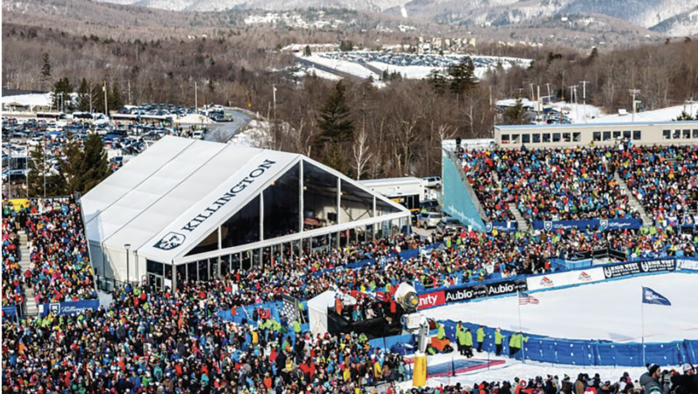It’s bigger than a race, the Stifel Killington Cup is a celebration of the history and passion for Alpine ski racing. In addition to watching the fastest female ski racers in Slalom and Giant Slalom battle for the top prize on the signature Superstar trail, the weekend is packed full of entertainment including live music, fireworks, movie screenings, panel discussions, a vendor village and after parties.
Killington Resort is excited to welcome World Cup athletes back to Killington for the seventh time over Thanksgiving Weekend. Tens of thousands of spectators will enjoy the live action, while millions more will watch the races broadcast in over 60 countries.
The Stifel Killington Cup had its largest single-day attendance record on Saturday, Nov. 30, 2019 with 19,500 spectators for the Giant Slalom event. Spectating at the Killington Cup every year is estimated to be over 30,000 both race days combined —and there are more that attend activities around the races — and, of course, those that came to ski and ride.
The volume and passion of the fans sends a clear message: Alpine ski racing is alive and well in the East.
This year, the action will kick off with a parade of young aspiring athletes from clubs around the state and region — it marks the return of this popular event after a hiatus due to the pandemic. The young racers will be representing their ski clubs, full of anticipation to watch the best female Alpine skiers in the world show their skills on Superstar. Five-time Killington Cup victor Mikaela Shiffrin is always the crowd favorite and has risen to even greater heights of stardom since she first graced the slopes of Superstar in the debut Killington Cup of 2016. She has now won more World Cups than any other Alpine racer (male or female). Having been schooled at Burke Mountain Academy, Vermont gets particularly excited to cheer for Shiffrin.
The 2016 second event in Killington was the first FIS Ski World Cup held in the eastern USA since 1991 at Waterville Valley, New Hampshire and the second in Vermont since 1978 at Stratton Mountain.

Killington’s Superstar Trail (the race trail) was selected because very little work needed to be done on it to make it FIS compliant and race-ready. It is 4,800 feet long, and drops 1,200 vertical feet with a pitch of 30 to 50 degrees.
Crews work hard to make it incredibly slick! More than 15 million gallons of water are used to cover Superstar Trail with 3-5 feet of snow, which takes about 100 hours of snowmaking. Then course crews inject it with water to make it extra firm — icy!
The firmer the course the better it will hold up through the lineup of racers and through various weather events that otherwise could lead to postponement of races.
When a course is injected, high-pressure hoses force water 1 or 2 feet deep into the snow through small nozzles along long metal bars.
Injection can be used on portions of a race course or on the whole thing. It is more common for a full course injection to be used for the technical races (Slalom and Giant Slalom) where the courses are shorter and the gates closer together.
In two-run races — like the Giant Slalom and Slalom races at the Killington Cup — the top 30 skiers from the first run go in reverse order in the second, so if the course doesn’t hold up well, the lower-ranked skiers could have an advantage.
Because FIS courses get so slick, more than 5 kilometers of safety fence are utilized on the race hill for racers safety. Additionally, U.S. Ski and Snowboard provides Killington with around two dozen airbags,
Blue dye at the edge of the course is another safety feature, helping racers when visibility is difficult. Crews carry backpacks of dye to spray reapplying as needed throughout the event, in order to adjust to varying conditions and help all racers equally.
Next coaches from different counties set the course.
In 2023, the Giant Slalom on Saturday, will be set by Swiss coach Alois Prenn for the first run and German coach Markus Lenz for the second.
For Sunday’s Slalom race, the first run will be set by Swedish coach Walter Girardi and the second run by Italian coach Roberto Lorenzi.
The course setter decides where to put each gate, with an eye for interesting and challenging terrain. Safety is a big factor.
The distance between the gates ranges between 7 and 13 meters. The course setter takes into account the distance and vertical drop of the hill to decide how many gates are needed to meet International Ski Federation standards.
Superstar typically has about 60 gates in the Slalom and 40 gates in Giant Slalom.

